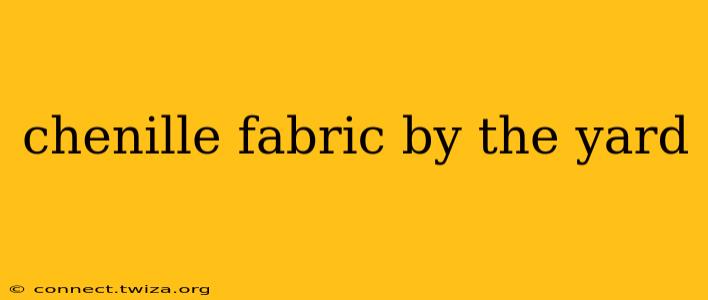Chenille fabric, with its plush, velvety texture and rich appearance, has been a favorite among crafters and designers for generations. Its unique construction gives it a distinctive softness and drape, making it ideal for a wide range of projects, from cozy throws and elegant curtains to stunning upholstery and vibrant clothing. This comprehensive guide will delve into everything you need to know about buying chenille fabric by the yard, including its characteristics, uses, care instructions, and where to find high-quality options.
What is Chenille Fabric?
Chenille fabric is a type of woven fabric characterized by its soft, fuzzy pile. This pile is created through a unique weaving process where multiple yarns are intertwined to form a loop-like structure, giving it its characteristic texture. The name "chenille" comes from the French word for "caterpillar," reflecting the fuzzy, worm-like appearance of the pile. This pile can be short and dense, creating a smooth, velvety feel, or longer and more loosely woven, resulting in a more textured, luxurious appearance. The pile can also be made from different materials, impacting the overall feel and drape of the fabric.
What are the Different Types of Chenille Fabric?
Several types of chenille fabrics exist, each possessing unique characteristics:
- Cotton Chenille: A popular choice for its breathability, softness, and affordability. It's perfect for home décor projects like blankets and curtains.
- Polyester Chenille: Known for its durability, wrinkle resistance, and easy care. This type is often used in upholstery and durable home goods.
- Rayon Chenille: Offers a luxurious drape and a shimmering sheen. It's often chosen for clothing and high-end decorative projects.
- Blends: Many chenille fabrics are blends of different fibers, combining the best qualities of each. For example, a cotton-polyester blend might offer the softness of cotton with the durability of polyester.
Choosing the right type of chenille depends on your project's intended use and desired aesthetic.
What are the Pros and Cons of Chenille Fabric?
Pros:
- Soft and Luxurious: Its plush pile makes it incredibly comfortable and visually appealing.
- Versatile: Suitable for a wide array of applications, from clothing to home décor.
- Durable: Depending on the fiber content, chenille can be quite durable, resisting wear and tear.
- Easy to Clean: Generally easy to clean, though specific care instructions vary depending on the fiber content.
Cons:
- Can Shed: Some chenille fabrics, especially those with longer pile, can shed initially.
- Can be Expensive: High-quality chenille, particularly those made with luxurious fibers like rayon, can be pricier than other fabrics.
- Can be Difficult to Sew: The pile can sometimes be challenging to work with when sewing.
Where Can I Buy Chenille Fabric by the Yard?
Chenille fabric is widely available from various sources:
- Online Retailers: Websites specializing in fabrics offer a vast selection of colors, patterns, and types of chenille. Many allow you to order by the yard.
- Local Fabric Stores: Brick-and-mortar fabric stores are a great place to see and feel the fabric before buying. They can also offer expert advice on selection and care.
- Craft Stores: Larger craft stores often carry a selection of chenille in popular colors and patterns.
How Do I Care for Chenille Fabric?
Proper care will ensure your chenille fabric remains looking its best for years to come. Always check the care label for specific instructions, but general guidelines include:
- Dry Cleaning: Many chenille fabrics, especially those with delicate fibers, are best dry-cleaned.
- Hand Washing: Some chenille can be hand-washed in cold water using a mild detergent. Avoid harsh scrubbing.
- Air Drying: Always air dry your chenille fabric to prevent shrinkage and damage. Avoid using a dryer.
What Projects Can I Make with Chenille Fabric?
The versatility of chenille makes it suitable for countless projects:
- Throws and Blankets: The soft, plush texture makes it ideal for cozy home textiles.
- Curtains and Drapes: Chenille drapes can add a touch of elegance and luxury to any room.
- Upholstery: Durable chenille is a popular choice for upholstery projects, adding both comfort and style.
- Clothing: Chenille can be used to create stylish garments, particularly jackets, skirts, and scarves.
- Accessories: Chenille can be used to create a variety of accessories such as pillows, bags, and headbands.
Is Chenille Fabric Easy to Sew?
While generally manageable, sewing chenille can present some challenges. The pile can be tricky to work with, so using sharp needles and a walking foot can improve your results. Pre-washing the fabric is also recommended to prevent shrinkage and ensure accurate cutting.
How Much Chenille Fabric Do I Need?
The amount of chenille fabric you need depends entirely on your project. Carefully measure your pattern or project dimensions to determine your yardage requirements. Always add extra fabric to account for potential mistakes or pattern matching.
What is the Difference Between Chenille and Velvet?
While both chenille and velvet are plush fabrics, they differ in their construction. Velvet is made by cutting the pile loops, creating a smooth, even surface. Chenille, on the other hand, keeps the pile loops intact, giving it a more textured look. This fundamental difference impacts their drape, texture, and overall appearance.
This comprehensive guide should equip you with the knowledge to confidently select and utilize chenille fabric by the yard for your next creative endeavor. Remember to always check the care label and consider the fiber content before beginning your project. Happy crafting!
